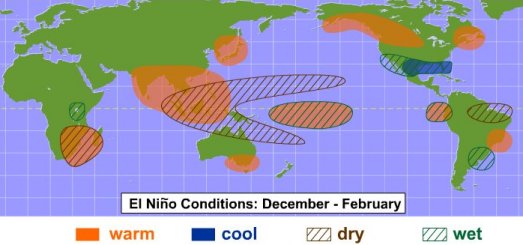

Conclusion
The seasonal changes that occurred in the subtropical jet stream during the 1982-1983 cold season was more than just an effect of the ongoing El Niño; the El Niño itself was the root cause of these changes. The warm surface waters associated with the El Niño was responsible for the strengthening of the subtropical jet by increasing the temperature gradients in the Pacific Ocean, as I previously mentioned. Had there not been an El Niño and had sea-surface temperatures been closer to average for the cold season, the subtropical jet would not have been nearly as potent across the eastern half of the Pacific. Therefore, it is safe to say that the El Niño was the cause of the changes in the subtropical jet.
The impact the relationship between El Niño and the subtropical jet has on seasonal weather patterns is not set in stone. During an El Niño, the Gulf Coast tends to be cooler and wetter than normal between the months of December through February. While precipitation was above normal during the 1982-1983 cold season, temperatures were warmer than what they should have been.

The typical weather patterns associated with El Niño during the months of December through February. Along the Gulf Coast, the seasonal weather tends to be cooler and wetter than normal. (Courtesy of the Department of Meteorology, Penn State University.)
The above normal temperatures for an El Niño episode shows that weather patterns associated with El Niño cannot be predicted with certainty. Other atmospheric signals can be greater than an El Niño’s effect on weather patterns, as was the case for temperatures in the Gulf Coast States. While an El Niño can impact weather patterns, it is not always the determining factor for them.



